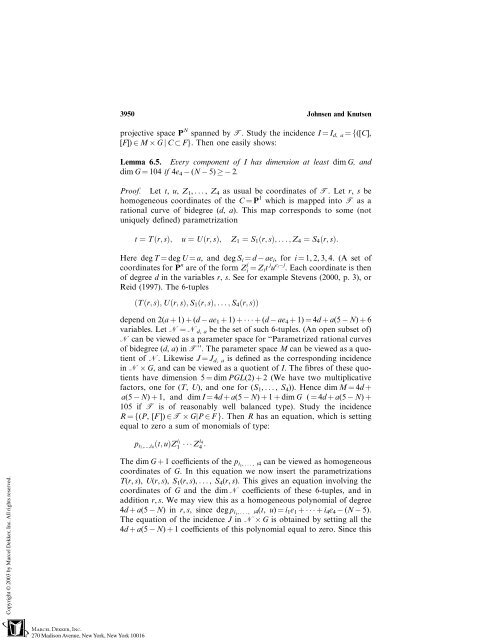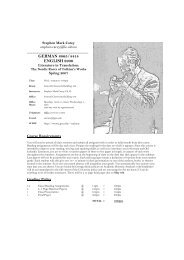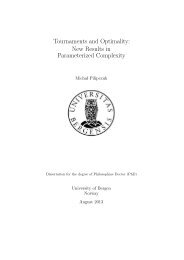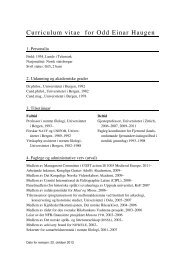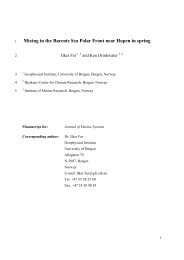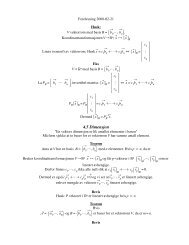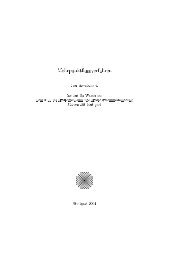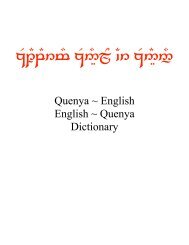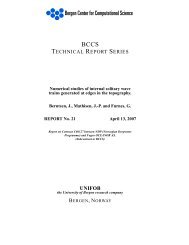Rational Curves in Calabi-Yau Threefolds
Rational Curves in Calabi-Yau Threefolds
Rational Curves in Calabi-Yau Threefolds
Create successful ePaper yourself
Turn your PDF publications into a flip-book with our unique Google optimized e-Paper software.
3950 Johnsen and Knutsen<br />
projective space P N spanned by T. Study the <strong>in</strong>cidence I ¼ Id, a ¼f([C],<br />
[F]) 2 M G j C Fg. Then one easily shows:<br />
Lemma 6.5. Every component of I has dimension at least dim G, and<br />
dim G ¼ 104 if 4e 4 (N 5) 2.<br />
Proof. Let t, u, Z1, ..., Z4 as usual be coord<strong>in</strong>ates of T. Let r, s be<br />
homogeneous coord<strong>in</strong>ates of the C ¼ P 1 which is mapped <strong>in</strong>to T as a<br />
rational curve of bidegree (d, a). This map corresponds to some (not<br />
uniquely def<strong>in</strong>ed) parametrization<br />
t ¼ Tðr; sÞ; u ¼ Uðr; sÞ; Z1 ¼ S1ðr; sÞ; ...; Z4 ¼ S4ðr; sÞ:<br />
Here deg T ¼ deg U ¼ a, and deg Si ¼ d aei, for i ¼ 1, 2, 3, 4. (A set of<br />
coord<strong>in</strong>ates for P n are of the form Z j<br />
i ¼ Zit j u ei j<br />
. Each coord<strong>in</strong>ate is then<br />
of degree d <strong>in</strong> the variables r, s. See for example Stevens (2000, p. 3), or<br />
Reid (1997). The 6-tuples<br />
ðTðr; sÞ; Uðr; sÞ; S1ðr; sÞ; ...; S4ðr; sÞÞ<br />
depend on 2(a þ 1) þ (d ae1 þ 1) þ þ(d ae4 þ 1) ¼ 4d þ a(5 N) þ 6<br />
variables. Let N ¼ Nd, a be the set of such 6-tuples. (An open subset of)<br />
N can be viewed as a parameter space for ‘‘Parametrized rational curves<br />
of bidegree (d, a) <strong>in</strong>T’’. The parameter space M can be viewed as a quotient<br />
of N. Likewise J ¼ J d, a is def<strong>in</strong>ed as the correspond<strong>in</strong>g <strong>in</strong>cidence<br />
<strong>in</strong> N G, and can be viewed as a quotient of I. The fibres of these quotients<br />
have dimension 5 ¼ dim PGL(2) þ 2 (We have two multiplicative<br />
factors, one for (T, U), and one for (S1, ..., S4)). Hence dim M ¼ 4d þ<br />
a(5 N) þ 1, and dim I ¼ 4d þ a(5 N) þ 1 þ dim G ( ¼ 4d þ a(5 N) þ<br />
105 if T is of reasonably well balanced type). Study the <strong>in</strong>cidence<br />
R ¼f(P, [F ]) 2 T GjP 2 F g. Then R has an equation, which is sett<strong>in</strong>g<br />
equal to zero a sum of monomials of type:<br />
pi1;...;i4ðt; uÞZi1 1<br />
Z i4<br />
4 :<br />
The dim G þ 1 coefficients of the p i1, ..., i4 can be viewed as homogeneous<br />
coord<strong>in</strong>ates of G. In this equation we now <strong>in</strong>sert the parametrizations<br />
T(r, s), U(r, s), S1(r, s), ..., S4(r, s). This gives an equation <strong>in</strong>volv<strong>in</strong>g the<br />
coord<strong>in</strong>ates of G and the dim N coefficients of these 6-tuples, and <strong>in</strong><br />
addition r, s. We may view this as a homogeneous polynomial of degree<br />
4d þ a(5 N) <strong>in</strong>r, s, s<strong>in</strong>ce deg pi 1, ..., i4(t, u) ¼ i1e1 þ þi4e4 (N 5).<br />
The equation of the <strong>in</strong>cidence J <strong>in</strong> N G is obta<strong>in</strong>ed by sett<strong>in</strong>g all the<br />
4d þ a(5 N) þ 1 coefficients of this polynomial equal to zero. S<strong>in</strong>ce this


